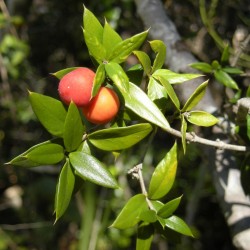Menu
-
MenuBack
- Home
-
Categories
-
-
Categories
-
Vegetable Seeds
-
Varieties by Country
- Varieties from Armenia
- Varieties from BiH
- Varieties from Croatia
- Varieties from France
- Varieties from Germany
- Varieties from Greece
- Varieties from Hungary
- Varieties from India
- Varieties from Italy
- Varieties from Japan
- Varieties from North Macedonia
- Varieties from Peru
- Varieties from Russia
- Varieties from Serbia
- Varieties from Slovenia
- Varieties from Spain
- Varieties from Thailand
- Varieties from Turkey
- Varieties from USA
- Tomato Seeds
- Corn Seeds
- Gourd family
- Bean family
- Cucumber Seeds
- Pepper Seeds
- Carrot family
- Onion family
- Lettuce Seeds
- Potato family
- Cabbage family
- Radish Seeds
- Beetroot family
- Watermelon Seeds
- Melon Seeds
- Cauliflower Seeds
- Sunflower family
-
Varieties by Country
- Fruit Seeds
- Chili - Habanero Seeds
- Medicinal Herb Seeds
- Climbing Plants Seeds
- Trees Bonsai Seeds
- Palm Seeds
- Ornamental Grasses Seeds
- Tobacco Seeds
-
Vegetable Seeds
-
-
-
-
- NEW PRODUCTS
- Create account
- Delivery - Payment
- FAQ
- Home
-
- Large Packets of Seeds
- Giant Plants Seeds
- Vegetable Seeds
- Varieties by Country
- Varieties from Armenia
- Varieties from BiH
- Varieties from Croatia
- Varieties from France
- Varieties from Germany
- Varieties from Greece
- Varieties from Hungary
- Varieties from India
- Varieties from Italy
- Varieties from Japan
- Varieties from North Macedonia
- Varieties from Peru
- Varieties from Russia
- Varieties from Serbia
- Varieties from Slovenia
- Varieties from Spain
- Varieties from Thailand
- Varieties from Turkey
- Varieties from USA
- Tomato Seeds
- Corn Seeds
- Gourd family
- Bean family
- Cucumber Seeds
- Pepper Seeds
- Carrot family
- Onion family
- Lettuce Seeds
- Potato family
- Cabbage family
- Radish Seeds
- Beetroot family
- Watermelon Seeds
- Melon Seeds
- Cauliflower Seeds
- Sunflower family
- Varieties by Country
- Fruit Seeds
- Chili - Habanero Seeds
- Medicinal Herb Seeds
- Climbing Plants Seeds
- Trees Bonsai Seeds
- Banana Seeds
- Palm Seeds
- Ornamental Grasses Seeds
- Tobacco Seeds
- Flower Seeds
- Cactus Seeds
- Water plants seeds
- Sowing Instructions
- Fruit and vegetable molds
- Mushroom Mycelium
- Plant Bulbs
- Bamboo seeds
- Ayurveda Plants
- F1 Hybrid Seeds
- Packaging and stuff
- Cold-resistant plants
- Plants Care
- Organic Spices
- Delivery - Payment
- No PayPal and Card payment X
Last Product Reviews
Out of the two seeds, one germinated and the other one was dead and floatin...
By
 Riikka H on 07/03/2024
Riikka H on 07/03/2024
Verified Purchase
There are 1772 products.
Showing 1441-1455 of 1772 item(s)

Giant plant (with giant fruits)
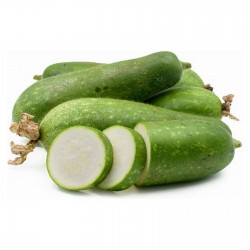
Wax gourd seeds (Benincasa...
Price
€2.25
(SKU: VE 225)
Seeds Gallery EU,
5/
5
<h2 class=""><strong>Wax gourd seeds (Benincasa hispida)</strong></h2>
<h2><span style="color: #ff0000;"><strong>Price for Package of 10 seeds.</strong></span></h2>
<p>Benincasa hispida, the wax gourd, also called ash gourd, white gourd, winter gourd, tallow gourd, ash pumpkin, and winter melon and “Chinese preserving melon” is a vine grown for its very large fruit, eaten as a vegetable when mature.</p>
<p>It is the only member of the genus Benincasa. The fruit is fuzzy when young. The immature melon has thick white flesh that is sweet when eaten. By maturity, the fruit loses its hairs and develops a waxy coating, giving rise to the name wax gourd, and providing a long shelf life. The melon may grow as large as 80 cm in length. It has yellow flowers and broad leaves. The taste is rather bland.</p>
<p>It is native to South Asia and Southeast Asia. The wax gourd is widely grown throughout Asia, including Java and Japan, the places where it is thought to have originated.</p>
<p>The name “winter melon” that is sometimes given to this plant is based on the Chinese name dōngguā (冬瓜), however, the character 瓜 (guā) can also mean “gourd” or “squash”. It is likely that the name “melon” is given because this gourd is sometimes candied or made into a sweet tea; see the Uses section below.</p>
<p><strong>Cultivation</strong></p>
<p>It is grown in well-drained loam and sandy soils, in warm mild climates, but will not tolerate frosts. The crops are grown in riverbeds or furrows, and needs constant irrigation during the growing season.</p>
<p><strong>Uses</strong></p>
<p>The wax gourd requires very warm weather to grow but can be stored for many months much like winter squash. Ash gourds of the Indian subcontinent have a white coating with rough texture (hence the name ash gourd, literally, in some vernaculars). South East Asian varieties have a smooth waxy texture. It is one of the few vegetables available during winter in areas of deciduous vegetation, hence its Chinese name literally means 'winter gourd'. The Wax Gourd can typically be stored for 12 months. In India, the wax gourd is recognized for its medicinal properties in the Ayurvedic system of medicine.[8] It is also has significance in spiritual traditions of India and Yoga, where it is identified as a great source of Prana.</p>
<p>In Vietnamese cuisine, it is called bí đao, which is usually used to make soup or stew.[11] When cooked with pork short ribs, the resulting soup is traditionally thought to help produce more milk for breastfeeding mothers.</p>
<p>In Chinese cuisine the gourds are used in stir fry or usually combined with pork or pork/beef bones to make winter gourd soup, often served in the scooped out gourd, carved by scraping off the waxy coating. It is also chopped and candied[12][unreliable source?] as wintermelon candy (táng dōng guā) to be commonly eaten at New Year festivals, or as filling for Sweetheart cake (lǎopó bǐng). It has also been used as the base filling in Chinese and Taiwanese mooncakes for the Moon Festival.</p>
<p>In the Philippines it is candied (referred to plainly as kundol) and is used as a pastry filling for bakpia (hopia in the Philippines). It is also an ingredient in some savory soups (sabaw) and stir-fries (guisado).</p>
<p>In Indian cuisine this gourd is traditionally used to prepare a wide variety of dishes. In northern India it is used to prepare a candy called petha. In South Indian cuisine, it is traditionally used to make a variety of curries, including a stew made with a yogurt base.[13] The juice of raw ash gourd(Maipawl) is used by the Mizo community of North-East India as a natural remedy to treat mild to severe dysentery. In north India, particularly in middle Himalayas, it is paired with pulses such as moong which when squashed along with winter gourd results in the making of a dish locally called bari. When dried in the cool winter sunlight it becomes somewhat hard and is used as a curry dish and eaten along with rice or chapati. This practice is done in Himalayas for quite a long time as people in mountains depend upon nature to help them survive harsh winters. This bari is a great source of iron and vitamins and eaten diversely in the mountains.</p>
<p>In Andhra Pradesh, it is called "boodidi gummidikaya" (Telugu language). It is used to make stews, stir fry and vadialu. Vadialu (plural; vadiam is singular) are made by chopping the gourd in small pieces and mixing with yogurt and spices, then sun-drying. To eat, vadiams are deep fried in oil and eaten as an accompaniment to rice and sambar (dish) or lentil stews.</p>
<p>In Kerala, the plant is called Kumbalam (കുമ്പളം) and the fruit is called Kumbalanga (കുമ്പളങ്ങ) or Kooshmandam (കൂശ്മാണ്ടം). It is traditionally used to offer 'Guruthi' (ഗുരുതി) instead of 'Kuruti' (കുരുതി) among Malayali Brahmins. It means, instead of offering someone's life in the pier, an ash gourd is cut into two as a symbolic performance in lieu human sacrifice.</p>
<p>In the Gujarat, is called kolu (કોળુ).</p>
<p>In Nepal, where it is called Kubhindo, it is cooked as a vegetable when young, but the ripe gourds are usually popular in making preserves or crystallized candied sweet known as "murabba" or "petha".[14][unreliable source?]</p>
<p>Occasionally, it is used to produce a fruit drink with a very distinctive taste. It is usually sweetened with caramelized sugar. In Southeast Asia, the drink is widely marketed as wax gourd tea or wax gourd punch.</p>
<p>The shoots, tendrils, and leaves of the plant may also be eaten as greens.</p>
VE 225 (10 S)


Variety from Japan
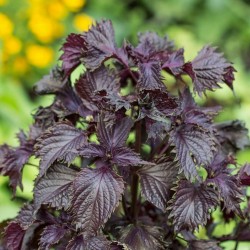
Purple Shiso Seeds (Perilla...
Price
€1.55
(SKU: MHS 18)
Seeds Gallery EU,
5/
5
<h2 class=""><strong>Purple Shiso Seeds (Perilla frutescens var. crispa)</strong></h2>
<h2><span style="color: #ff0000;" class=""><strong>Price for Package of 50 (0,09g) seeds.</strong></span></h2>
<p>Perilla frutescens var. crispa, or shiso (/ˈʃiːsoʊ/,[2] from the Japanese シソ), belongs to the genus Perilla, in the mint family, Lamiaceae. Shiso is a perennial plant that may be cultivated as an annual in temperate climates. The plant occurs in purple-leaved ("red") and green-leaved ("green") forms. There are also frilly ruffled-leaved forms (chirimen-jiso) and forms that are red only on the underside (katamen-jiso). Different parts of the plant have a number of culinary uses in East Asian and Southeast Asian cuisine.</p>
<p><strong>Names</strong></p>
<p>This herb has also been known in English as the "beefsteak plant", possibly on account of the purple-leaved varieties evoking the bloody-red color of meat.[3] It is sometimes referred to by its genus name, perilla, but this is ambiguous as it could also refer to a different cultigen (Perilla frutescens var. frutescens) which is distinguished as egoma in Japan and tul-kkae or "wild sesame" in Korea.[4][5] The perilla or "beefsteak plant" began to be recognized by the native Japanese name shiso among American diners of Japanese cuisine, especially aficionados of sushi in the later decades of the 20th century.[6]</p>
<p>In Japan, the cultigen is called shiso (紫蘇/シソ; [ɕiso̞]).[7][8] In Vietnam, it is called tía tô ([tiɜ˧ˀ˦ to˧]).[9] The Japanese name shiso and the Vietnamese tía tô are cognates, each loan words from zǐsū (紫苏/紫蘇),[10] which means Perilla frutescens in Chinese. (Perilla frutescens var. crispa is called huíhuísū (回回苏/回回蘇) in Chinese.) The first character 紫[11] means "purple",[7] and the second 蘇[12] means "to be resurrected, revived, rehabilitated". In Japan, shiso traditionally denoted the purple-red form.[13] In recent years, green is considered typical, and red considered atypical.[citation needed]</p>
<p>The red-leaved form of shiso was introduced into the West around the 1850s,[14] when the ornamental variety was usually referred to as P. nankinensis. This red-leafed border plant eventually earned the English-language name "beefsteak plant".</p>
<p>Other common names include "perilla mint",[15] "Chinese basil",[16][17][18] and "wild basil".[16] The alias "wild coleus"[19] or "summer coleus"[16] probably describe ornamental varieties. The red shiso or su tzu types are called purple mint[16] or purple mint plant.[15] It is called rattlesnake weed[16] in the Ozarks, because the sound the dried stalks make when disturbed along a footpath is similar to a rattlesnake's rattling sound.</p>
<p><strong>Origins and distribution</strong></p>
<p>Suggested native origins are mountainous terrains of India and China,[21] although some books say Southeast Asia.</p>
<p>Shiso spread throughout ancient China. One of the early mentions on record occurs in Renown Physician's Extra Records (Chinese: 名醫別錄; pinyin: Míng Yī Bié Lù), around 500 AD,[23] where it is listed as su (蘇), and some of its uses are described.</p>
<p>The perilla was introduced into Japan around the eighth to ninth centuries.</p>
<p>The species was introduced into the Western horticulture as an ornamental and became widely naturalized and established in the United States and may be considered weedy or invasive.</p>
<p><strong>Description</strong></p>
<p>Though now lumped into a single species of polytypic character, the two cultigens continue to be regarded as distinct commodities in the Asian countries where they are most exploited. While they are morphologically similar, the modern strains are readily distinguishable. Accordingly, the description is used separately or comparatively for the cultivars.</p>
<p>Shiso grows to 40–100 centimetres (16–39 in) tall.[25] It has broad ovate leaves with pointy ends and serrated margins, arranged oppositely with long leafstalks.[citation needed] Shiso's distinctive flavor comes from its perillaldehyde component,[26] which present only in low concentration in other perilla varieties.</p>
<p> </p>
<p>The red (purple) forms of the shiso (forma purpurea and crispa) come from its pigment, called "perilla anthocyanin" or shisonin[27] The color is present in both sides of the leaves, the entire stalk, and flower buds (calyces).</p>
<p>The red crinkly-leafed version (called chirimenjiso in Japan) was the form of shiso first examined by Western botany, and Carl Peter Thunberg named it P. crispa (the name meaning "wavy or curly"). That Latin name was later retained when the shiso was reclassed as a variety.</p>
<p>Bicolored cultivars (var. Crispa forma discolor Makino; カタメンジソ (katamenjiso) or katamen shiso) are red on the underside of the leaf.[28][29] Green crinkly-leafed cultivars (called chirimenaojiso, forma viridi-crispa) are seen.</p>
<p>Shiso produces harder, smaller seeds compared to other perilla varieties.[30][31] Shiso seeds weigh about 1.5 g per 1000 seeds.[32]</p>
<p><strong>Red shiso</strong></p>
<p>The purple-red type may be known as akajiso (赤ジソ/紅ジソ "red shiso"). It is often used for coloring umeboshi (English: pickled plum). The shiso leaf turns bright red when it reacts with the umezu, the vinegary brine that wells up from the plums after being pickled in their vats.[7][33] The red pigment is identified as the Perilla anthocyanin, a.k.a. shisonin.[34] The mature red leaves make undesirable raw salad leaves, but germinated sprouts, or me-jiso (芽ジソ), have been long used as garnish to accent a Japanese dish, such as a plate of sashimi.[7][35] The tiny pellets of flower-buds (ho-jiso) and seed pods (fruits) can be scraped off using the chopstick or fingers and mixed into the soy sauce dip to add the distinct spicy flavor, especially to flavor fish.[35][36]</p>
<p><strong>Green shiso</strong></p>
<p>Bunches of green shiso-leaves packaged in styrofoam trays can be found on supermarket shelves in Japan and Japanese food markets in the West. Earnest production of the leafy herb did not begin until the 1960s. Shimbo (2001), p. 58</p>
<p>One anecdote is that c. 1961, a cooperative or guild of tsuma (ツマ "garnish") commodities based in Shizuoka Prefecture picked large-sized green leaves of shiso and shipped them to the Osaka market. They gained popularity such that ōba (大葉 "big leaf") became the trade name for bunches of picked green leaves.</p>
<p>A dissenting account places its origin in the city of Toyohashi, Aichi, the foremost ōba-producer in the country,[38] and claims Toyohashi's Greenhouse Horticultural Agricultural Cooperative[a] experimented with planting c. 1955, and around 1962 started merchandizing the leaf part as Ōba. In 1963 they organized "cooperative sorting and sales" of the crop (kyōsen kyōhan (共選・共販), analogous to cranberry cooperatives in the US) and c. 1970 they achieved year-round production.[39]</p>
<p>The word ōba was originally a trade name and was not entered into the Shin Meikai kokugo jiten until its 5th edition (Kindaichi (1997)) and is absent from the 4th edition (1989). This dictionary is more progressive than the Kojien cited previously, as Kindaichi's dictionary, from the 1st ed. (1972), and definitely in the 2nd ed. (1974) defined shiso as a plant with leaves of "purple(green) color".[40]</p>
<p><strong>Chemical composition</strong></p>
<p>Shiso contain only about 25.2–25.7% lipid,[41] but still contains a comparable 60% ratio of ALA.[42][43]</p>
<p>The plant produces the natural product perilloxin, which is built around a 3-benzoxepin moiety. Perilloxin inhibits the enzyme cyclooxygenase with an IC50 of 23.2 μM.[44] Non-steroidal anti-inflammatory drugs like aspirin and ibuprofen also work by inhibiting the cyclooxygenase enzyme family.</p>
<p>Of the known chemotypes of perilla, PA (main component: perillaldehyde) is the only one used for culinary purposes. Other chemotypes are PK (perilla ketone), EK (eschscholzia ketone), PL (perillene), PP (phenylpropanoids: myristicin, dillapiole, elemicin), C (citral) and a type rich in rosefuran.</p>
<p>Perilla ketone is toxic to some animals. When cattle and horses consume purple mint (of the PK chemotype) while grazing in fields in which it grows, the perilla ketone causes pulmonary edema, leading to a condition sometimes called perilla mint toxicosis.</p>
<p>The oxime of perillaldehyde (perillartin) is used as an artificial sweetener in Japan, as it is about 2,000 times sweeter than sucrose.</p>
<p>The pronounced flavor and aroma of shiso derives from perillaldehyde,[45] but this substance is lacking in the "wild sesame" and "sesame leaf" variety. Other aromatic essential oils present are limonene,[45] caryophyllene,[45] and farnesene.[citation needed]</p>
<p>Many forms are rich in perilla ketone, which is a potent lung toxin to some livestock,[46] though effects on humans remains to be studied.[46]</p>
<p>The artificial sweetener perillartine can be synthesized from perillaldehyde, but it is used in Japan only for sweetening tobacco,[47] despite being 2000 times sweeter than sucrose, owing to its bitterness and aftertaste, and insolubility in water.[48]</p>
<p><strong>Cultivation</strong></p>
<p>In temperate climates, the plant is self-sowing, but the seeds[ambiguous] are not viable after long storage, and germination rates are low after a year.</p>
<p>The weedy types have often lost the characteristic shiso fragrance and are not suited for eating (cf. perilla ketone). Also, the red leaves are not ordinarily served raw.</p>
<p><strong>Culinary use</strong></p>
<p>See under Perilla for a survey of the herbal and spice uses of the species in different countries</p>
<p><strong>Japan</strong></p>
<p>Called shiso (紫蘇) in Japanese, P. frutescens var. crispa leaves, seeds, and sprouts are used extensively in Japanese cuisine. Green leaves, called aojiso (青紫蘇; "blue shiso"), are used as a herb in cold noodle dishes (hiyamugi and sōmen), cold tofu (hiyayakko), tataki and namerō. Aojiso is also served fresh with sashimi. Purple leaves, called akajiso (赤紫蘇; "red shiso"), are used to dye pickled plums (umeboshi). Shiso seed pods are salted and preserved to be used as a spice, while the germinated sprouts called mejiso (芽紫蘇) are used as garnish. The inflorescence of shiso, called hojiso (穂紫蘇), is used as garnish on a sashimi plate.</p>
<p>The Japanese name for the variety of perilla normally used in Japanese cuisine (Perilla frutescens var. crispa) is shiso (紫蘇). This name is already commonplace in US mass media's coverage of Japanese restaurants and cuisine. The Japanese call the green type aojiso (青紫蘇), or ooba ("big leaf"), and often eat the fresh leaves with sashimi (sliced raw fish) or cut them into thin strips in salads, spaghetti, and meat and fish dishes. It is also used as a savory herb in a variety of dishes, even as a pizza topping (initially it was used in place of basil). In the summer of 2009, Pepsi Japan released a seasonal flavored beverage, Pepsi Shiso.</p>
<p>The Japanese shiso leaves grow in green, red, and bicolored forms, and crinkly (chirimen-jiso) varieties, as noted. Parts of the plants eaten are the leaves, flower and buds from the flower stalks, fruits and seeds, and sprouts.</p>
<p>The purple form is called akajiso (赤紫蘇, red shiso), and is used to dye umeboshi (pickled ume) red or combined with ume paste in sushi to make umeshiso maki. It can also be used to make a sweet, red juice to enjoy during summer.</p>
<p>Japanese use green shiso leaves raw with sashimi. Dried leaves are also infused to make tea.[citation needed] The red shiso leaf is not normally consumed fresh, but needs to be e.g. cured in salt.[clarification needed] The pigment in the leaves turns from purple to bright red color when steeped in umezu, and is used to color and flavor umeboshi.</p>
<p>An inflorescence of shiso, called hojiso (ear shiso), is typically used as garnish on a sashimi plate; the individual flowers can be stripped off the stem using the chopstick, adding its flavor to the soy sauce dip. The fruits of the shiso (shiso-no-mi), containing fine seeds (mericarp) about 1 mm or less in diameter (about the size of mustard seed), can be preserved in salt and used as a spice or condiment. Young leaves and flower buds are used for pickling in Japan and Taiwan.</p>
<p>The other type of edible perilla (Perilla frutescens) called egoma (荏胡麻) is of limited culinary importance in Japan, though this is the variety commonly used in nearby Korea. The cultivar is known regionally as jūnen in the Tohoku (northeast) regions of Japan. The term means "ten years", supposedly because it adds this many years to one's lifespan. A preparation called shingorō, made in Fukushima prefecture, consists of half-pounded unsweet rice patties which are skewered, smeared with miso, blended with roasted and ground jūnen seeds, and roasted over charcoal. The oil pressed from this plant was once used to fuel lamps in the Middle Ages.[clarification needed] The warlord Saitō Dōsan, who started out in various occupations, was a peddler of this type of oil, rather than the more familiar rapeseed oil, according to a story by historical novelist Ryōtarō Shiba.</p>
<p>A whole leaf of green shiso is often used as a receptacle to hold wasabi, or various tsuma (garnishes) and ken (daikon radishes, etc., sliced into fine threads). It seems to have superseded baran,[citation needed] the serrated green plastic film, named after the Aspidistra plant, once used in takeout sushi boxes.</p>
<p><strong>Green leaves</strong></p>
<p>The green leaf can be chopped and used as herb or condiment for an assortment of cold dishes such as:</p>
<p>cold noodles (hiyamugi, sōmen)</p>
<p>cold tofu (known as Hiyayakko)</p>
<p>tataki and namerō</p>
<p>Chopped leaves can be used to flavor any number of fillings or batter to be cooked, for use in warm dishes. A whole leaf battered on the obverse side is made into tempura.[50] Whole leaves are often combined with shrimp or other fried items.</p>
<p><strong>Red leaves</strong></p>
<p>Red leaves are used for making pickled plum (umeboshi) as mentioned, but this is no longer a yearly chore undertaken by the average household. Red shiso is used to color shiba-zuke [ja], a type of pickled eggplant served in Kyoto. (Cucumber, myoga, and shiso seeds may also be used),[51] Kyoto specialty.</p>
<p><strong>Seeds</strong></p>
<p>The seed pods or berries of the shiso may be salted and preserved like a spice.[52] They can be combined with fine slivers of daikon to make a simple salad.</p>
<p>One source from the 1960s says that oil expressed from shiso seeds was once used for deep-frying purposes.</p>
<p><strong>Sprouts</strong></p>
<p>The germinated sprouts (cotyledons)[53] used as garnish are known as mejiso (芽ジソ). Another reference refers to the me-jiso as the moyashi (sprout) of the shiso.[7]</p>
<p>Any time it is mentioned that shiso "buds" are used, there is reason to suspect this is a mistranslation for "sprouts" since the word me (芽) can mean either.[54][b]</p>
<p>Though young buds or shoots are not usually used in restaurants, the me-jiso used could be microgreen size.[55] People engaged in growing their own shiso in planters refer to the plucked seedlings they have thinned as mejiso.[56][better source needed]</p>
<p><strong>Yukari</strong></p>
<p>The name yukari refers to dried and pulverized red-shiso flakes,[57] and has become as a generic term,[58] although Mishima Foods Co. [ja] insists it is the proprietary name for its products.[59] The term yukari-no-iro has signified the color purple since the Heian period, based on a poem in the Kokin Wakashū (c. 910) about a murasaki or gromwell blooming in Musashino (an old name for the Tokyo area).[60] Moreover, the term Murasaki-no-yukari [ja] has been used as an alias for Lady Murasaki's romance of the shining prince.</p>
<p> </p>
<p><strong>Furikake</strong></p>
<p>Other than the yukari variety, there are many commercial brand furikake-type sprinkle-seasoning products that contain shiso. They can be sprinkled on rice or mixed into musubi. They are often sprinkled on pasta.</p>
<p>Shiso pasta can be made from fresh-chopped leaves, sometimes combined with the crumbled roe of tarako.[61] Rather than cooking the cod roe, the hot pasta is tossed into it.</p>
<p><strong>Korea</strong></p>
<ol>
<li>frutescens var. crispa, called soyeop (소엽) or chajogi (차조기), is a less-popular culinary plant than P. frutescens in Korea. It is, however, a commonly seen wild plant, and the leaves are occasionally used as a ssam vegetable.[62] The purplish leaves are sometimes pickled in soy sauce or soybean paste as a jangajji, or deep-fried with a thin coat of rice-flour batter.[62]</li>
</ol>
<p><strong>Laos</strong></p>
<p>The purple leaves, called pak maengda (ຜັກແມງດາ), are strong in fragrance, but not ruffled. They are used for Lao rice vermicelli, khao poon (ເຂົ້າປຸ້ນ), which is very similar to the Vietnamese bún. They are used as part of the dish for their fragrance.</p>
<p><strong>Vietnam</strong></p>
<p>Tía tô is a cultivated P. frutescens var. crispa in Vietnam,[63] which compared to the Japanese shiso has slightly smaller leaves but much-stronger aromatic flavor. It is native to Southeast Asia.[64][65] Unlike the Perilla frutescens counterpart, the leaves on the Vietnamese perilla have green color on the top side and purplish-red on the bottom side.</p>
<p>In North and South Vietnam, the Vietnamese perilla are eaten raw or used in Vietnamese salads, soups, or stir-fried dishes. The strong flavors are perfect for cooking seafoods such as shrimp and fish dishes. Aromatic leaves are also widely used in pickling. Plants can be grown in open fields, gardens, or containers.</p>
<p>Vietnamese cuisine uses a P. frutescens var. crispa variety similar to the Japanese perilla, but with greenish bronze on the top face and purple on the opposite face. The leaves are smaller and have a much stronger fragrance. In Vietnamese, it is called tía tô, derived from the characters (紫蘇) whose standard pronunciation in Vietnamese is tử tô. It is usually eaten as a garnish in rice vermicelli dishes called bún and a number of stews and simmered dishes.</p>
<p><strong>Ornamental use</strong></p>
<p>The red-leaved shiso, in earlier literature referred to as Perilla nankinensis, became available to gardening enthusiasts in England circa 1855.[14] By 1862, the English were reporting overuse of this plant, and proposing Coleus vershaeffeltii [66] or Amaranthus melancholicus var. ruber made available by J.G. Veitch [67] as an alternative.</p>
<p>It was introduced later in the United States, perhaps in the 1860s.[68][69]</p>
<p><strong>Nutritional</strong></p>
<p>Bactericidal and preservative effects of the shiso, due to the presence of terpenes such as perilla alcohol, have been noted.</p>
<script src="//cdn.public.n1ed.com/G3OMDFLT/widgets.js"></script>
MHS 18 (0.09 g)


Variety from France
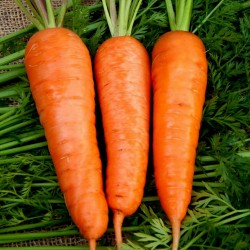
Carrot Flakkee Seeds
Price
€2.05
(SKU: VE 192)
Seeds Gallery EU,
5/
5
<meta http-equiv="Content-Type" content="text/html; charset=UTF-8" />
<h2><strong>Carrot Flakkee Seeds</strong></h2>
<h2><span style="color: #ff0000;"><strong>Price for Package of 500 (0,6g) seeds.</strong></span></h2>
<p>Flakkee is easy to grow and although considered a main crop variety, can be successionally planted to give a continuous crop, producing large, thick roots. It has very good color and flavor. It will thrive in even rather poor soils but give it some encouragement and you will be amazed and the results.</p>
<p>Carrot is one of the least demanding of crops and probably the widest grown vegetable in British gardens</p>
VE 192 (500 S)


Variety from Hungary
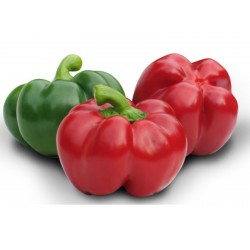
GREYGO Hungarian sweet...
Price
€1.55
(SKU: PP 68)
Seeds Gallery EU,
5/
5
<meta http-equiv="Content-Type" content="text/html; charset=UTF-8" />
<h2><strong>GREYGO Hungarian sweet pepper seeds</strong></h2>
<h2><span style="color: #ff0000;"><strong>Price for Package of 20 seeds.</strong></span></h2>
<p>Hungarian pepper of the tomato type. Plant height is 50-60 cm. Wrinkled leaf, The variety is insensitive to lack of light. The fruits are sweet, of immature dark green color and dark red at full maturity. Excellent for fresh use and cooking. Disease-resistant and suitable for indoor and outdoor production.</p>
<p><strong>One of the most popular peppers in Hungary.</strong></p>
PP 68 (20 S)


Plant resistant to cold and frost

Coming Soon
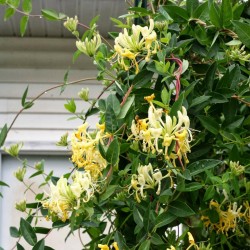
Italian woodbine seeds...
Price
€1.95
(SKU: MHS 36)
Seeds Gallery EU,
5/
5
<!DOCTYPE html>
<html>
<head>
<meta http-equiv="Content-Type" content="text/html; charset=UTF-8" />
</head>
<body>
<h2><strong>Italian woodbine seeds (Lonicera caprifolium)</strong></h2>
<h2><span style="color: #ff0000;"><strong>Price for Package of 10 seeds.</strong></span></h2>
<p>Lonicera caprifolium, the Italian woodbine, perfoliate honeysuckle, goat-leaf honeysuckle, Italian honeysuckle, or perfoliate woodbine, is a species of perennial flowering plants in the genus Lonicera of the family Caprifoliaceae. It is native to parts of Europe, and naturalised in South East Britain and northeastern North America. It can readily be distinguished from Europe's most common species, Lonicera periclymenum, by its topmost leaves, which are perfoliate as the Latin name suggests (that is, the stem appears to grow through the centre of the leaf). It is a vigorous, deciduous climber growing up to 8 metres. It bears masses of very fragrant, cream-coloured flowers, tinged with pink, appearing in midsummer.</p>
</body>
</html>
MHS 36 (10 S)

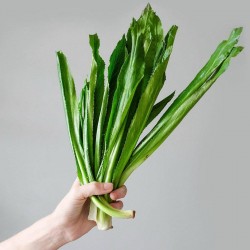
Mexican Coriander Seeds...
Price
€1.95
(SKU: MHS 32)
Seeds Gallery EU,
5/
5
<meta http-equiv="Content-Type" content="text/html; charset=UTF-8" />
<h2><strong>Mexican Coriander Seeds (Eryngium foetidum)</strong></h2>
<h2><span style="color: #ff0000;"><strong>Price for a Package of 20 seeds.</strong></span></h2>
<p>Eryngium foetidum is a tropical perennial herb in the family Apiaceae. Common names include culantro , recao, shadow beni, Mexican coriander, bhandhania, long coriander, sawtooth coriander, and ngò gai. It is native to Mexico, the Caribbean, Central and South America, but is cultivated worldwide, sometimes being grown as an annual in temperate climates.</p>
<p>In the United States, the common name culantro sometimes causes confusion with cilantro, a common name for the leaves of Coriandrum sativum (also in Apiaceae), of which culantro is said to taste like a stronger version.</p>
<p><strong>Uses</strong></p>
<p><strong>Culinary</strong></p>
<ol>
<li>foetidum is widely used in seasoning, marinating and garnishing in the Caribbean, particularly in Cuba, Dominican Republic, Puerto Rico, Trinidad and Tobago, Panama, Guyana, Suriname, and in Ecuador and Peru's Amazon regions. It is used extensively in Cambodia, Thailand, India, Vietnam, Laos,Myanmar and other parts of Asia as a culinary herb.[5] It dries well, retaining good color and flavor, making it valuable in the dried herb industry. It is sometimes used as a substitute for coriander, but it has a much stronger taste.</li>
</ol>
<p> </p>
<p>In the United States, E. foetidum grows naturally in Florida, Georgia, Hawaii, Puerto Rico, and the Virgin Islands.</p>
<p><strong>Traditional medicine</strong></p>
<ol>
<li>foetidum has been used in traditional medicine in tropical regions for burns, earache, fevers, hypertension, constipation, fits, asthma, stomachache, worms, infertility complications, snake bites, diarrhea, and malaria.</li>
<li>foetidum is also known as E. antihystericum.[8] The specific name antihystericum reflects the fact that this plant has traditionally been used for epilepsy.[9] The plant is said to calm a person's 'spirit' and thus prevents epileptic 'fits', so is known by the common names spiritweed and fitweed. The anticonvulsant properties of this plant have been scientifically investigated.[10][medical citation needed] A decoction of the leaves has been shown to exhibit anti-inflammatory and analgesic effects in rats.</li>
</ol>
<p>Eryngial is a chemical compound isolated from E. foetidum.[12] The University of the West Indies at Mona, Jamaica, has investigated the use of enyngial as a treatment for human Strongyloides stercoralis infection (strongyloidiasis).</p>
<p>It is used as an ethnomedicinal plant for the treatment of a number of ailments such as fevers, chills, vomiting, burns, fevers, hypertension, headache, earache, stomachache, asthma, arthritis, snake bites, scorpion stings, diarrhea, malaria and epilepsy.[medical citation needed] The main constituent of essential oil of the plant is eryngial (E-2-dodecenal). A pharmacological investigation claims to have demonstrated anthelmintic, anti-inflammatory, analgesic, anticonvulsant, anticlastogenic, anticarcinogenic, antidiabetic, and antibacterial activity.</p>
<p> </p>
MHS 32 (20 S)

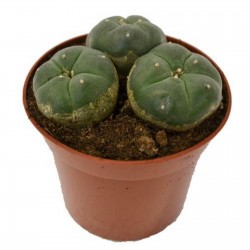
Peyote Seeds (Lophophora...
Price
€2.85
(SKU: CT 2)
Seeds Gallery EU,
5/
5
<h2><strong>Peyote Seeds (Lophophora williamsii)</strong></h2>
<h2><span style="color: #ff0000;"><strong>Price for Package of 5 seeds.</strong></span></h2>
<p>Lophophora williamsii (/loʊˈfɒfərə wɪliˈæmsiaɪ/) or peyote (/pəˈjoʊti/) is a small, spineless cactus with psychoactive alkaloids, particularly mescaline. Peyote is a Spanish word derived from the Nahuatl, or Aztec, peyōtl [ˈpejoːt͡ɬ], meaning "glisten" or "glistening". Other sources translate the Nahuatl word as "Divine Messenger".[3][4] Peyote is native to Mexico and southwestern Texas. It is found primarily in the Chihuahuan Desert and in the states of Coahuila, Nuevo León, Tamaulipas, and San Luis Potosí among scrub. It flowers from March to May, and sometimes as late as September. The flowers are pink, with thigmotactic anthers (like Opuntia).</p>
<p>Known for its psychoactive properties when ingested, peyote is used worldwide,[citation needed] having a long history of ritualistic and medicinal use by indigenous North Americans. Peyote contains the hallucinogen mescaline.</p>
<p>The various species of the genus Lophophora grow low to the ground and they often form groups with numerous, crowded shoots. The blue-green, yellow-green or sometimes reddish-green shoots are mostly flattened spheres with sunken shoot tips. They can reach heights of from 2 to 7 centimeters (0.79 to 2.76 in) and diameters of 4 to 12 cm (1.6 to 4.7 in). There are often significant, vertical ribs consisting of low and rounded or hump-like bumps. From the cusp areoles arises a tuft of soft, yellowish or whitish woolly hairs. Spines are absent. Flowers are pink or white to slightly yellowish, sometimes reddish. They open during the day, are from 1 to 2.4 cm long, and reach a diameter from 1 to 2.2 cm.</p>
<p>The cactus produces flowers sporadically; these are followed by small edible pink fruit. The club-shaped to elongated, fleshy fruits are bare and more or less rosy colored. At maturity, they are brownish-white and dry. The fruits do not burst open on their own and they are between 1.5 and 2 cm long. They contain black, pear-shaped seeds that are 1 to 1.5 mm long and 1 mm wide. The seeds require hot and humid conditions to germinate. Peyote contains a large spectrum of phenethylamine alkaloids. The principal one is mescaline for which the content of Lophophora williamsii is about 0.4% fresh[5] (undried) and 3–6% dried.</p>
<p>Peyote is extremely slow growing. Cultivated specimens grow considerably faster, sometimes taking less than three years to go from seedling to mature flowering adult. More rapid growth can be achieved by grafting peyote onto mature San Pedro root stock. The top of the above-ground part of the cactus, the crown, consists of disc-shaped buttons. These are cut above the roots and sometimes dried. When done properly, the top of the root forms a callus and the root does not rot.< When poor harvesting techniques are used, however, the entire plant dies. Currently in South Texas, peyote grows naturally but has been over-harvested, to the point that the state has listed it as an endangered species.[citation needed] The buttons are generally chewed, or boiled in water to produce a psychoactive tea. Peyote is extremely bitter and most people are nauseated before they feel the onset of the psychoactive effects.</p>
<p><strong>Uses</strong></p>
<p><strong>Psychoactive and medicinal</strong></p>
<p>When used for its psychoactive properties, common doses for pure mescaline range from roughly 200 to 400 mg. This translates to a dose of roughly 10 to 20 g of dried peyote buttons of average potency; however, potency varies considerably between samples, making it difficult to measure doses accurately without first extracting the mescaline. The effects last about 10 to 12 hours.[10] Peyote is reported to trigger rich visual or auditory effects (see synesthesia).</p>
<p>In addition to psychoactive use, some Native American tribes use the plant in the belief it may have curative properties. They employ peyote to treat such varied ailments as toothache, pain in childbirth, fever, breast pain, skin diseases, rheumatism, diabetes, colds, and blindness. Peyote also contains an alkaloid called peyocactin. It is now called hordenine. Peyote poisoning has been a concern in California.</p>
<p><strong>History</strong></p>
<p>In 2005 researchers used radiocarbon dating and alkaloid analysis to study two specimens of peyote buttons found in archaeological digs from a site called Shumla Cave No. 5 on the Rio Grande in Texas. The results dated the specimens to between 3780 and 3660 BCE. Alkaloid extraction yielded approximately 2% of the alkaloids including mescaline in both samples. This indicates that native North Americans were likely to have used peyote since at least five-and-a-half thousand years ago.[16]</p>
<p>Specimens from a burial cave in west central Coahuila, Mexico have been similarly analyzed and dated to 810 to 1070 CE.</p>
<p>From earliest recorded time, peyote has been used by indigenous peoples, such as the Huichol[18] of northern Mexico and by various Native American tribes, native to or relocated to the Southern Plains states of present-day Oklahoma and Texas. Its usage was also recorded among various Southwestern Athabaskan-language tribal groups. The Tonkawa, the Mescalero, and Lipan Apache were the source or first practitioners of peyote religion in the regions north of present-day Mexico.[19] They were also the principal group to introduce peyote to newly arrived migrants, such as the Comanche and Kiowa from the Northern Plains. The religious, ceremonial, and healing uses of peyote may date back over 2,000 years.</p>
<p>Under the auspices of what came to be known as the Native American Church, in the 19th century, American Indians in more widespread regions to the north began to use peyote in religious practices, as part of a revival of native spirituality. Its members refer to peyote as "the sacred medicine", and use it to combat spiritual, physical, and other social ills. Concerned about the drug's psychoactive effects, between the 1880s and 1930s, U.S. authorities attempted to ban Native American religious rituals involving peyote, including the Ghost Dance. Today the Native American Church is one among several religious organizations to use peyote as part of its religious practice. Some users claim the drug connects them to God.</p>
<p>Traditional Navajo belief or ceremonial practice did not mention the use of peyote before its introduction by the neighboring Utes. The Navajo Nation now has the most members of the Native <strong>American Church.</strong></p>
<p>Dr. John Raleigh Briggs (1851–1907) was the first to draw scientific attention of the Western scientific world to peyote.[22] Louis Lewin described Anhalonium lewinii in 1888.[23] Arthur Heffter conducted self experiments on its effects in 1897.[24] Similarly, Norwegian ethnographer Carl Sofus Lumholtz[25] studied and wrote about the use of peyote among the Indians of Mexico. Lumholtz also reported that, lacking other intoxicants, Texas Rangers captured by Union forces during the American Civil War soaked peyote buttons in water and became "intoxicated with the liquid".</p>
<p>The US Dispensatory lists peyote under the name Anhalonium, and states it can be used in various preparations for neurasthenia, hysteria and asthma.</p>
<p><strong>Adverse reactions</strong></p>
<p>A study published in 2007 found no evidence of long-term cognitive problems related to peyote use in Native American Church ceremonies, but researchers stressed their results may not apply to those who use peyote in other contexts.[27] A four-year large-scale study of Navajo who regularly ingested peyote found only one case where peyote was associated with a psychotic break in an otherwise healthy person; other psychotic episodes were attributed to peyote use in conjunction with pre-existing substance abuse or mental health problems.[28] Later research found that those with pre-existing mental health issues are more likely to have adverse reactions to peyote.[29] Peyote use does not appear to be associated with hallucinogen persisting perception disorder (a.k.a. "flashbacks") after religious use.[30] Peyote does not seem to be associated with physical dependence, but some users may experience psychological dependence.</p>
<p>Peyote can have strong emetic effects, and one death has been attributed to esophageal bleeding caused by vomiting after peyote ingestion in a Native American patient with a history of alcohol abuse.[32] Peyote is also known to cause potentially serious variations in heart rate, blood pressure, breathing, and pupillary dilation.</p>
<p>Research into the huichol natives of central-western Mexico, who have taken peyote regularly for an estimated 1,500 years or more, found no evidence of chromosome damage in either men or women.</p>
CT 2 (5 S)

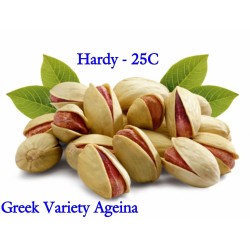
Pistachio Seeds Greek...
Price
€6.15
(SKU: V 187 G)
Seeds Gallery EU,
5/
5
<!DOCTYPE html>
<html>
<head>
<meta http-equiv="Content-Type" content="text/html; charset=UTF-8" />
</head>
<body>
<h2><strong>Pistachio Seeds Greek Variety "Aegina" (Pistacia vera)</strong></h2>
<h2><span style="color: #ff0000;"><strong>Price for Package of 5, 20, 50, 100, 500 seeds.</strong></span></h2>
<p><strong>Best Pistachio in Greece is the Greek Variety "Aegina"!</strong><br />There are many Pistacia species in Greece. Pistacia vera is the only nut for human consumption in Greece. Other Pistacia species such as Pistacia palaestina, P. terebinthus and P. lentiscus are used as ornamental shrubs. "Aegina" is the main edible cultivar in Greece. <br />The nut of the variety "Aegina" contains 55% fat, 23% proteins, and 14% carbohydrate. So it has a high nutritional value and lately, it has enjoyed increasing popularity. Also, the weight of one "Aegina" pistachio nut (dry) is averaged 0,97– 1,12 g. The moisture content of pistachio is around 7,5–9 % on the dry matter during storage conditions.</p>
<p><strong>NUTRITIONAL INFORMATION:</strong></p>
<p>Compared to other pistachio varieties including California grown</p>
<p>GENUINE GAZIANTEP PISTACHIOS CONTAIN:</p>
<p>50% less fat</p>
<p>40% less carbohydrates</p>
<p>200% more vitamin C</p>
<p>70% more iron</p>
<p>20% more calcium</p>
<p> 23% more magnesium</p>
<h2>Wikipedia:</h2>
<p>The pistachio (/pɪˈstɑːʃiˌoʊ, -ˈstæ-/,[1] Pistacia vera), a member of the cashew family, is a small tree originating from Central Asia and the Middle East.[2] The tree produces seeds that are widely consumed as food.</p>
<p>Pistacia vera often is confused with other species in the genus Pistacia that are also known as pistachio. These other species can be distinguished by their geographic distributions (in the wild) and their seeds which are much smaller and have a soft shell.</p>
<p><strong>History</strong></p>
<p>Archaeology shows that pistachio seeds were a common food as early as 6750 BC.[3] Pliny the Elder writes in his Natural History that pistacia, "well known among us", was one of the trees unique to Syria, and that the seed was introduced into Italy by the Roman Proconsul in Syria, Lucius Vitellius the Elder (in office in 35 AD) and into Hispania at the same time by Flaccus Pompeius.[4] The early sixth-century manuscript De observatione ciborum ("On the observance of foods") by Anthimus implies that pistacia remained well known in Europe in Late Antiquity. Archaeologists have found evidence from excavations at Jarmo in northeastern Iraq for the consumption of Atlantic pistachio.[3] The Hanging Gardens of Babylon were said to have contained pistachio trees during the reign of King Merodach-Baladan about 700 BC.</p>
<p>The modern pistachio P. vera was first cultivated in Bronze Age Central Asia, where the earliest example is from Djarkutan, modern Uzbekistan.[5][6] It appears in Dioscurides as pistakia πιστάκια, recognizable as P. vera by its comparison to pine nuts.</p>
<p>Additionally, remains of the Atlantic pistachio and pistachio seed along with nut-cracking tools were discovered by archaeologists at the Gesher Benot Ya'aqov site in Israel's Hula Valley, dated to 780,000 years ago.[8] More recently, the pistachio has been cultivated commercially in many parts of the English-speaking world, in Australia, and in New Mexico[9] and California, of the United States, where it was introduced in 1854 as a garden tree.[10] David Fairchild of the United States Department of Agriculture introduced hardier cultivars collected in China to California in 1904 and 1905, but it was not promoted as a commercial crop until 1929.[9][11] Walter T. Swingle’s pistachios from Syria had already fruited well at Niles by 1917.</p>
<p>The earliest records of pistachio in English are around roughly year 1400, with the spellings "pistace" and "pistacia". The word pistachio comes from medieval Italian pistacchio, which is from classical Latin pistacium, which is from ancient Greek pistákion and pistákē, which is generally believed to be from Middle Persian, although unattested in Middle Persian. Later in Persian, the word is attested as pesteh. As mentioned, the tree came to the ancient Greeks from Western Asia.</p>
<p><strong>Habitat</strong></p>
<p>Pistachio is a desert plant, and is highly tolerant of saline soil. It has been reported to grow well when irrigated with water having 3,000–4,000 ppm of soluble salts.[9] Pistachio trees are fairly hardy in the right conditions, and can survive temperatures ranging between −10 °C (14 °F) in winter and 48 °C (118 °F) in summer. They need a sunny position and well-drained soil. Pistachio trees do poorly in conditions of high humidity, and are susceptible to root rot in winter if they get too much water and the soil is not sufficiently free-draining. Long, hot summers are required for proper ripening of the fruit. They have been known to thrive in warm, moist environments.</p>
<p>The Jylgyndy Forest Reserve, a preserve protecting the native habitat of Pistacia vera groves, is located in the Nooken District of Jalal-Abad Province of Kyrgyzstan.</p>
<p><strong>Characteristics</strong></p>
<p>The bush grows up to 10 m (33 ft) tall. It has deciduous pinnate leaves 10–20 centimeters (4–8 inches) long. The plants are dioecious, with separate male and female trees. The flowers are apetalous and unisexual, and borne in panicles.</p>
<p>The fruit is a drupe, containing an elongated seed, which is the edible portion. The seed, commonly thought of as a nut, is a culinary nut, not a botanical nut. The fruit has a hard, creamish exterior shell. The seed has a mauvish skin and light green flesh, with a distinctive flavor. When the fruit ripens, the shell changes from green to an autumnal yellow/red, and abruptly splits part way open (see photo). This is known as dehiscence, and happens with an audible pop. The splitting open is a trait that has been selected by humans.[14] Commercial cultivars vary in how consistently they split open.</p>
<p>Each pistachio tree averages around 50 kilograms (110 lb) of seeds, or around 50,000, every two years.</p>
<p>The shell of the pistachio is naturally a beige color, but it is sometimes dyed red or green in commercial pistachios. Originally, dye was applied by importers to hide stains on the shells caused when the seeds were picked by hand. Most pistachios are now picked by machine and the shells remain unstained, making dyeing unnecessary except to meet ingrained consumer expectations. Roasted pistachio seeds can be artificially turned red if they are marinated prior to roasting in a salt and strawberry marinade, or salt and citrus salts.</p>
<p>Like other members of the Anacardiaceae family (which includes poison ivy, sumac, mango, and cashew), pistachios contain urushiol, an irritant that can cause allergic reactions.</p>
<p><strong>Production and cultivation</strong></p>
<p>Iran, the United States and Turkey are the major producers of pistachios, together accounting for 83% of the world production in 2013 (table).</p>
<p><strong>Cultivation</strong></p>
<p>The trees are planted in orchards, and take approximately seven to ten years to reach significant production. Production is alternate-bearing or biennial-bearing, meaning the harvest is heavier in alternate years. Peak production is reached around 20 years. Trees are usually pruned to size to make the harvest easier. One male tree produces enough pollen for eight to 12 drupe-bearing females. Harvesting in the United States and in Greece is often accomplished using equipment to shake the drupes off the tree. After hulling and drying, pistachios are sorted according to open-mouth and closed-mouth shells. Sun-drying has been found to be the best method of drying,[18] then they are roasted or processed by special machines to produce pistachio kernels.</p>
<p>Pistachio trees are vulnerable to a wide variety of diseases. Among these is infection by the fungus Botryosphaeria, which causes panicle and shoot blight (symptoms include death of the flowers and young shoots), and can damage entire pistachio orchards.</p>
<p>In Greece, the cultivated type of pistachios has an almost-white shell, sweet taste, a red-green kernel and a closed-mouth shell relative to the 'Kerman' variety. Most of the production in Greece comes from the island of Aegina, the region of Thessaly-Almyros and the regional units of West Attica, Corinthia and Phthiotis.</p>
<p>In California, almost all female pistachio trees are the cultivar 'Kerman'. A scion from a mature female 'Kerman' is grafted onto a one-year-old rootstock.</p>
<p>Bulk container shipments of pistachio kernels are prone to self-heating and spontaneous combustion because of their high fat and low water contents.</p>
<p><strong>Consumption</strong></p>
<p>The kernels are often eaten whole, either fresh or roasted and salted, and are also used in pistachio ice cream, kulfi, spumoni, historically in Neapolitan ice cream, pistachio butter,[21][22] pistachio paste[23] and confections such as baklava, pistachio chocolate,[24] pistachio halva,[25] pistachio lokum or biscotti and cold cuts such as mortadella. Americans make pistachio salad, which includes fresh pistachios or pistachio pudding, whipped cream, and canned fruit.</p>
<p>China is the top pistachio consumer worldwide, with annual consumption of 80,000 tons, while the United States consumes 45,000 tons.</p>
<p><strong>Nutritional information</strong></p>
<p>Pistachios are a nutritionally dense food. In a 100 gram serving, pistachios provide 562 calories and are a rich source (20% or more of the Daily Value or DV) of protein, dietary fiber, several dietary minerals and the B vitamins, thiamin and especially vitamin B6 at 131% DV (table).[28] Pistachios are a good source (10–19% DV) of calcium, riboflavin, vitamin B5, folate, vitamin E , and vitamin K (table).</p>
<p>The fat profile of raw pistachios consists of saturated fats, monounsaturated fats and polyunsaturated fats.[28][29] Saturated fatty acids include palmitic acid (10% of total) and stearic acid (2%).[29] Oleic acid is the most common monounsaturated fatty acid (51% of total fat)[29] and linoleic acid, a polyunsaturated fatty acid, is 31% of total fat.[28] Relative to other tree nuts, pistachios have a lower amount of fat and calories but higher amounts of potassium, vitamin K, γ-tocopherol, and certain phytochemicals such as carotenoids and phytosterols.</p>
<p><strong>Research and health effects</strong></p>
<p>In July 2003, the United States' Food and Drug Administration (FDA) approved the first qualified health claim specific to seeds lowering the risk of heart disease: "Scientific evidence suggests but does not prove that eating 1.5 ounces (42.5 g) per day of most nuts, such as pistachios, as part of a diet low in saturated fat and cholesterol may reduce the risk of heart disease".[31] Although pistachios contain many calories, epidemiologic studies have provided strong evidence that their consumption is not associated with weight gain or obesity.</p>
<p>A 2015 systematic review and meta-analysis of randomized controlled trials concluded that pistachio consumption in persons without diabetes mellitus appears to modestly lower systolic and diastolic blood pressure.[32] Several mechanisms for pistachios' antihypertensive properties have been proposed. These mechanisms include pistachios' high levels of the amino acid arginine (a precursor of the blood vessel dilating compound nitric oxide); high levels of phytosterols and monounsaturated fatty acids; and improvement of endothelial cell function through multiple mechanisms including reductions in circulating levels of oxidized low density lipoprotein cholesterol and pro-inflammatory chemical signals.</p>
<p><strong>Toxin and safety concerns</strong></p>
<p>As with other tree seeds, aflatoxin is found in poorly harvested or processed pistachios. Aflatoxins are potent carcinogenic chemicals produced by molds such as Aspergillus flavus and Aspergillus parasiticus. The mold contamination may occur from soil, poor storage, and spread by pests. High levels of mold growth typically appear as gray to black filament-like growth. It is unsafe to eat mold-infected and aflatoxin-contaminated pistachios.[33] Aflatoxin contamination is a frequent risk, particularly in warmer and humid environments. Food contaminated with aflatoxins has been found as the cause of frequent outbreaks of acute illnesses in parts of the world. In some cases, such as Kenya, this has led to several deaths.</p>
<p>Pistachio shells typically split naturally prior to harvest, with a hull covering the intact seeds. The hull protects the kernel from invasion by molds and insects, but this hull protection can be damaged in the orchard by poor orchard management practices, by birds, or after harvest, which makes it much easier for pistachios to be exposed to contamination. Some pistachios undergo so-called "early split", wherein both the hull and the shell split. Damage or early splits can lead to aflatoxin contamination.[35] In some cases, a harvest may be treated to keep contamination below strict food safety thresholds; in other cases, an entire batch of pistachios must be destroyed because of aflatoxin contamination. In September 1997, the European Union placed its first ban on pistachio imports from Iran due to high levels of aflatoxin. The ban was lifted in December 1997 after Iran introduced and improved food safety inspections and product quality.</p>
<p>Pistachio shells may be helpful in cleaning up pollution created by mercury emissions.</p>
</body>
</html>
V 187 G 20 S


Coming Soon
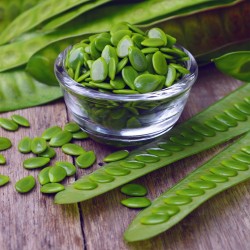
Miracle Tree, River...
Price
€1.95
(SKU: T 94)
Seeds Gallery EU,
5/
5
<h2><strong>Miracle Tree, River Tamarind Seeds (Leucaena leucocephala)</strong></h2>
<h2><span style="color: #ff0000;"><strong>Price for Package of 5 seeds.</strong></span></h2>
<p>Aka miracle tree, Koa Haole, white leadtree, river tamarind, subabul, jumbay, white popinac, phak krathin, guaje.</p>
<p>Organic, open pollinated, non-gmo seeds - Germination tested at >90+%.</p>
<p>One of the fastest growing trees in the world. When given water and fertilizer can easily reach 30+ feet in three years. Can also be used for firewood, timber, and in paper production. Great pioneer species for permaculture. Frost tolerant down to at least 18 degrees possibly lower when established, can sprout back from roots in especially cold winters. Loses leaves when temperatures drop but sprouts again early in spring.</p>
<p><strong>Use by humans</strong></p>
<p>During the 1970s and 1980s, it was promoted as a "miracle tree" for its multiple uses.[8] It has also been described as a "conflict tree" because it is used for forage production but spreads like a weed in some places.</p>
<p><strong>Food for humans</strong></p>
<p>The young pods are edible and occasionally eaten in Javanese vegetable salad with spicy peanut sauce, and spicy fish wrapped in papaya or taro leaves in Indonesia, and in papaya salad in Laos[10] and Thailand, where they are known as phak krathin (Thai: ผักกระถิน).[17] In Mexico it is eaten in soups and also inside tacos, it is known as guaje. Additionally, the state of Oaxaca in Mexico derives its name from the Nahuatl word huaxyacac, the name for Leucaena leucocephala trees that are found around Oaxaca City.</p>
<p>The legume is promoted in several countries of Southeast Asia (at least Burma, Cambodia, Laos,[10] and Thailand), most importantly as a source of quality animal feed, but also for residual use for firewood or charcoal production.</p>
<p>Beautiful white puffball flowers form into long seed pods in the second year. Can be planted alongside more tender fruit trees like avocados for protection until established or alley cropped with vegetables to provide windblock, trellis, or shade, and pollarded yearly to provide mulch, chopped down for biomass when desired or left as an ornamental to provide an exotic tropical look with dappled shade.</p>
<p>Extremely fast growing, cold hardy, subtropical, thornless, perennial, nitrogen fixing legume. Described as a miracle tree, it grows from seed to 10+ feet tree in a single season. Thrives in poor, rocky, clay soil, with full sun and heat with minimal water. This unique tree is also photosensitive and folds its leaves closed each night at sunset.</p>
<p>Seeds germinate easily if the proper procedure is followed. Seeds must be immersed in water that is heated to 170-180 degrees before planting to ensure germination.</p>
<p>Academic studies show best germination rates occur when seeds are immersed in hot water for 5 to 10 minutes. For best practice we recommend bring water to just before a boil(when bubbles start to form on the bottom of the pan), ideally 170-180 F (76-82 C), then pour the water into a coffee cup or heat safe container and toss the seeds in, allow to cool, and soak overnight. The seeds will swell two to three times in size when they are ready to be planted. Some can take 3-5 days. Take care not to damage any roots that may emerge. The hot water and soak cycle may be repeated with more stubborn seeds that don’t swell after 24 hours. Scarification by rubbing lightly against sandpaper or pavement before soaking can aid in faster germination but it is not necessary. It is important not to scratch too deep and damage the seed so we recommend patience. After seeds have swollen they can be planted in a sunny location.</p>
T 94 (5 S)


Coming Soon
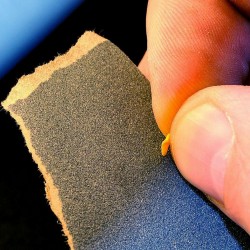
Plant seeds scarification
Price
€0.00
(SKU: )
Seeds Gallery EU,
5/
5
<div id="mntl-sc-block_1-0">
<h2><span style="color:#000000;"><strong>Plant seeds scarification</strong></span></h2>
<p><span style="color:#000000;">Scarification in botany involves weakening, opening, or otherwise altering the coat of a seed to encourage germination. The seeds of many plant species are often impervious to water and gasses, thus preventing or delaying germination. Scarification is often done mechanically, thermally, and chemically. </span></p>
<p><span style="color:#000000;">Seed scarification is scarring seeds. A seed's hard outer coat makes it impervious to gasses and moisture that would cause them to germinate. To overcome this you need to scratch, break or nick the seed coat. In nature, this naturally occurs when seeds pass through the digestive tract of some animals, through freezing temperatures or microbial activities that break down the seed coat. Seeds that need to be scarified before sowing are usually large or have thick seed coatings like seeds in the morning glory family, runner beans like purple hyacinth beans vine or canna seeds.</span></p>
<p><span style="color:#000000;">The process of seed scarification can be accomplished by rubbing the seed on file or sandpaper. Be careful not to go too deep into the seed itself. Scratch the seeds just enough that you can see a difference is color of the seeds should be enough. Water is easily soaked up through the seed coat after you've done this.</span></p>
<h2><span style="color:#000000;"><strong>Methods of Scarification of Seeds</strong></span></h2>
<p><span style="color:#000000;">Seeds with hard coats may need to be scarified - the process where the seed coat is modified in some way so that moisture can enter and germination occurs.</span></p>
<h2><span style="color:#000000;"><strong>There are several methods of scarification:</strong><strong></strong></span></h2>
</div>
<ol style="list-style-type:upper-alpha;"><li><span style="color:#000000;">Soaking the seeds in hot water</span></li>
<li><span style="color:#000000;">Damage hard outer seeds coat with Pliers, knife, nail clipper...</span></li>
<li><span style="color:#000000;">Using a file or sandpaper (one must be careful to not go too deep and damage the embryo inside)</span></li>
<li><span style="color:#000000;">Acid (this can be quite dangerous and you must follow directions carefully!).</span></li>
</ol><p><span style="color:#000000;">The type of scarification will depend on which seeds you are germinating.</span></p>
<h2><span style="color:#000000;"><strong><span class="mntl-sc-block-heading__text">Scarification Breaks Dormancy</span></strong></span></h2>
<p><span style="color:#000000;">Physical dormancy is due to structural limitations to germination such as hard impervious seed coats. Under natural conditions weathering for a number of years weakens the seed coat. Certain seeds, such as the sweet pea, have a tough husk that can be artificially worn or weakened to render the seed coat permeable to gasses and water by scarification. </span></p>
<p><span style="color:#000000;">In some tree species, dormancy is the result of a thick, hard seed coat that may be broken by scarification. In nature, the seed coat may be broken by microbial action, passage of the seed through the digestive tract of a bird or other animal, exposure to alternate freezing and thawing, or fire.</span></p>
<h2><span style="color:#000000;"><strong><span class="mntl-sc-block-heading__text">Seed Stratification</span></strong></span></h2>
<p><span style="color:#000000;">Seed stratification is sometimes better known as the cold stratification. The seed of many tree species will not germinate until they have been exposed to cool temperatures and moist conditions for several weeks or months. Gardeners can accomplish the same results indoors by a process called stratification. Tree seed can be stratified by placing the seed in a moist 50:50 mixture of sand and peat moss. Suitable containers include coffee cans, plastic jars, and cottage cheese containers. (Punch holes in the lid of the container to provide air.) Seed can also be stratified in plastic bags. Stratify the seed in the refrigerator.</span></p>
<p><span style="color:#000000;">The seed of some trees, such as redbud, have hard impermeable seed coats and dormant embryos. They require both scarification and stratification for germination.</span></p>
<p><span style="color:#000000;"><iframe width="640" height="385" src="https://www.youtube.com/embed/icB9HrqdQqU?rel=0&hd=1" frameborder="0" class="embed-responsive-item"> </iframe></span></p>


Giant plant (with giant fruits)
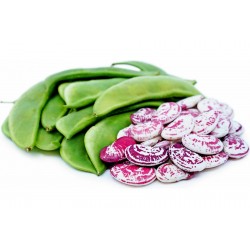
Giant Christmas Lima beans...
Price
€2.55
(SKU: VE 118)
Seeds Gallery EU,
5/
5
<h2><strong>Giant Christmas Lima beans seeds</strong></h2>
<h2><span style="color: #ff0000;"><strong>Price for Package of 5 seeds.</strong></span></h2>
<p>Originated in Peru, first recognized in the 1840s. This bean is also known as Chestnut Bean because of its flavor. The maroon markings remain even after cooking. Christmas Limas are now adapted to the high desert region of the American Southwest.</p>
<p><strong>Description/Taste</strong></p>
<p>Christmas Lima beans are tucked inside of a wide, curved and flat roughly four-inch green pod speckled with earthy brown tones. The pod is easily opened at its stringless seam, revealing three tender and semi-succulent creamy white beans that are variegated with raspberry-colored patterns. Eventually, the beans will harden and dry, their coloring reversing, with more of the beans' surface covered with tones of burgundy with white speckles. The flavor of Christmas Lima beans is buttery, sweet and reminiscent of chestnuts.</p>
<p><strong>Seasons/Availability</strong></p>
<p>Christmas Lima beans are appropriately available from fall to late winter.</p>
<p><strong>Current Facts</strong></p>
<p>Christmas Lima beans, Phaseolus lunatus, are defined in culinary terms, as a legume, their appearance as a pole bean merely serving the purpose of the pod securing the beans inside through maturity. Unlike snap beans, the pod is not eaten. Christmas Limas are an heirloom variety of Lima beans, their place within the commercial market quite rare, especially because they are mainly grown as a fresh shelling bean and most legumes are grown and processed as a dry or canned bean.</p>
<p><strong>Applications</strong></p>
<p>Christmas Lima beans do not require soaking. They can be simply rinsed prior to preparation. They can be treated as a fresh shelling bean or a dry bean, thus their cooking time will vary depending on their age. Christmas Lima beans compliment a variety of flavors and dishes from season to region. Hearty Winter stews, spicy soups, and bright, fresh Spring salads are each enhanced by Christmas Lima beans' buttery texture and nutty flavor. Christmas Limas are rich enough to stand up to curries and chiles, indulgent meats such as lamb and pork. They can also be prepared simply with the addition of olive oil, fresh herbs such as mint, cilantro, and basil. Perfect companion ingredients include garlic, forest mushrooms and fresh hulled corn along with cheeses like feta and gorgonzola.</p>
<p><strong>Geography/History</strong></p>
<p>Christmas Lima beans were named for Lima, Peru, the capital city that they were first cultivated in the 19th Century, although their exact origins are unknown. Christmas Limas perform best in similar climates that other pole beans thrive in. Their growing season is boosted by warm soil, arid climates and long sunny days. Regions throughout the Americas create abundant harvests of the Christmas Lima bean, though their commercial recognition is nearly obsolete. They have actually been listed as an endangered heirloom vegetable variety, at risk of becoming void of the food chain - this status is designed to promote and encourage the Christmas Lima to be grown by farmers and gardeners, to ensure they remain in production and in turn continue to be appreciated by consumers for decades and centuries to come.</p>
<script src="//cdn.public.n1ed.com/G3OMDFLT/widgets.js"></script>
VE 118 (5 S)


Variety from United States of America
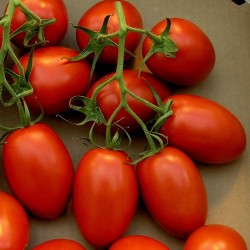
Roma Tomato Seeds
Price
€1.95
(SKU: VT 57)
Seeds Gallery EU,
5/
5
<h2><strong>Roma Tomato Seeds</strong></h2>
<h2><span style="color:#ff0000;"><strong>Price for Package of 20 seeds.</strong></span></h2>
<p>Roma tomatoes have an elongated egg-like shape, and they grow to about three inches long. Their bright red, smooth and thick skin houses meaty flesh with few seeds, high sugar, and acid levels, and low moisture content compared to other tomato varieties, ideal for cooking down into a tomato sauce or paste. The disease-resistant plants grow to an average of four to six feet, and because this is a determinate plant, the fruits will grow to a set height and ripen about the same time, producing one large crop typically toward the end of the season.</p>
<p>Roma tomatoes are very high in vitamin A and C, and like other red tomato varieties, they’re an inherently rich source of lycopene. Lycopene is a naturally occurring pigment that gives tomatoes their red coloring and doubles as a powerful antioxidant known for its anti-cancer benefits, such as preventing, fighting and repairing cell damage within human bodies, and for its ability to lower cholesterol. Roma tomatoes are also a decent source of iron and fiber, as well as potassium and the B vitamins, which are good for heart health.</p>
<p>Unlike a slicing tomato, Roma tomatoes are not juicy, and they have thicker and drier flesh that cooks down easily into a thick sauce. Cooking also intensifies their slightly sweet tomato flavor. Hence, Roma tomatoes are the trademark tomato for making sauces, pastes, and soups, although they do well in both cooked and raw preparations. They can be slow roasted, dried, stuffed and baked, and their meaty flesh also makes them great for fresh chopped salads and salsas, or adding into an omelet.</p>
<p>The Roma tomato developed out of the demands of early industrial agriculture in the United States. With the ability to ship greater distances, the high demand, and the relatively low aesthetic value of processing tomatoes post-WWII came the development of machine-harvestable, durable varieties, such as the Roma tomato. Genetic studies have proven that the change in the tomato’s shape from round to torpedo as well as the increased firmness of the tomato’s flesh was actually the result of a mutation in the tomato’s genes. This mutation was identified as SUN, named after the tomato variety Sun 1642. This gene causes uniform fruit elongation and is responsible for the Roma tomato's shape.</p>
<p>Roma tomatoes are a hybrid variety developed around 1955 and are believed to be a cross of the Pan American tomato with San Marzano, a paste tomato that was thought to have been brought into the United States by Italian immigrants. Roma tomatoes were bred specifically for their shape, disease resistance, and durability. With such qualities, the Roma tomato has been widely adopted throughout the United States and does well against diseases common in cool, wet climates.</p>
VT 57 (20 S)


Variety from Spain
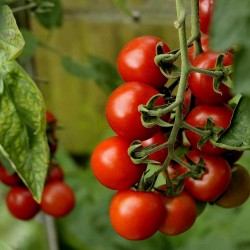
Authentic Alicante Tomato...
Price
€1.55
(SKU: VT 143)
Seeds Gallery EU,
5/
5
<h2><strong>Authentic Alicante Tomato Seeds</strong></h2>
<h2><span style="color:#ff0000;"><strong>Price for Package of 10 seeds.</strong></span></h2>
<p>Alicante is a Spain heirloom tomato variety. It is aromatic, deep red fruits have dark red skin and round shape. Their soft flesh is juicy and meaty, offering a robust and tangy flavor. The vigorous plants reach an average of up to 2 meters tall and produce masses of the 100-200 grams fruits throughout the season. Alicante tomatoes are open-pollinated</p>
<p>Alicante tomatoes can be used in raw and cooked applications, like grilling or broiling. They are known as an old, Spain preserving tomato, and are particularly well suited for canning and juicing. They are popular for making tomato sauce because of their rich, acidic flavor.</p>
<p>Alicante tomatoes have been treasured in Spain for generations, and are a popular ingredient in family recipes for pasta sauce and paste.</p>
<p>Alicante tomatoes have been passed down for generations in Spain, dating back to the early 18th century.</p>
VT 143 (10 S)

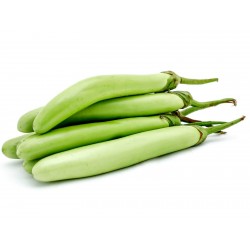
Thai Long Green Eggplant Seeds
Price
€2.25
(SKU: VE 93 LE)
Seeds Gallery EU,
5/
5
<h2><strong>Thai Long Green Eggplant Seeds (Solanum melongena)</strong></h2>
<h2><span style="color:#fd0202;"><strong>Price for Package of 10 seeds.</strong></span></h2>
<p>Thai Long Green Eggplant is the name for several varieties of eggplant used in Southeast Asian cuisines, most often of the eggplant species Solanum melongena. They are also cultivated in Sri Lanka and feature in Sri Lankan cuisine. These Long Green Eggplants are commonly used in Thai cuisine. Some of the cultivars in Thailand are Thai Purple, Thai Green, Thai Yellow, and Thai White.</p>
<p><strong>Uses</strong></p>
<p>The green variety of Thai eggplants are essential ingredients in Thai curry dishes such as in kaeng tai pla, green and red curry. They are often halved or quartered, but can also be used whole, and cooked in the curry sauce where they become softer and absorb the flavor of the sauce. They are also eaten raw in Thai salads or with Thai chili pastes (nam phrik).</p>
<p>Sometimes, in Thai restaurants outside of Thailand, Thai eggplants are replaced by locally available eggplants.</p>
VE 93 LE (10 S)





